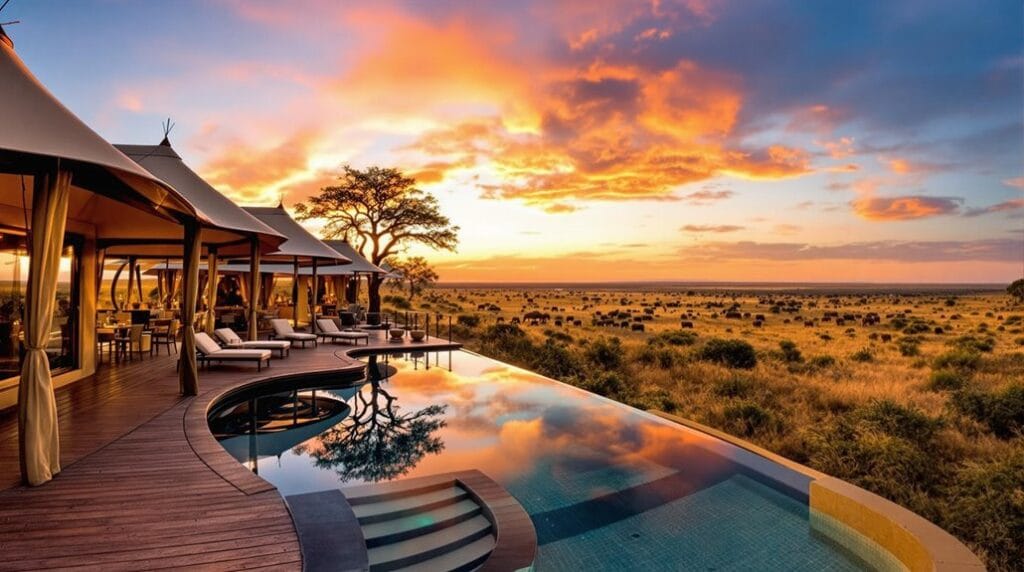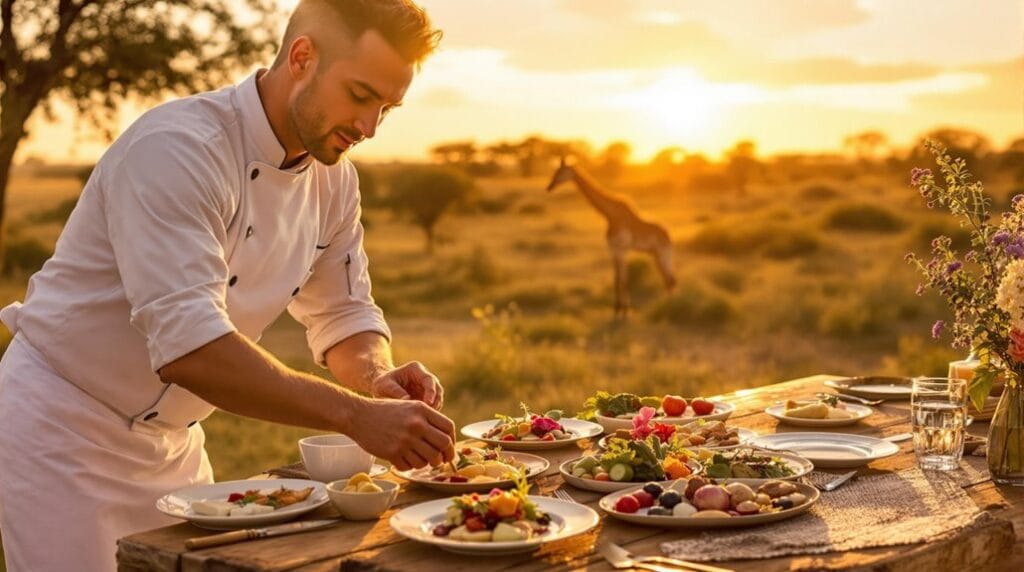You might think that Africa's musical instruments are merely exotic trinkets, but they're essential expressions of cultural identity and community. Each instrument, from the deep beats of the djembe to the soothing tones of the kora, holds stories that transcend generations. As you explore the craftsmanship behind these unique creations, you'll uncover how they shape social connections and reflect diverse histories. What you discover might challenge your perceptions and reveal a deeper understanding of the continent's rich musical landscape.
Key Takeaways
- African musical instruments like the djembe and kora play crucial roles in cultural ceremonies, storytelling, and community connections across diverse regions.
- Traditional craftsmanship utilizes local materials, ensuring sustainability and the preservation of cultural narratives through the artistry of instrument creation.
- Instruments foster social dynamics, with call-and-response patterns enhancing community engagement and reinforcing cultural identity during performances.
- Historical significance in African music, marked by polyrhythms, reflects cultural heritage and influences contemporary global music genres.
- Accessible music shops in Nairobi promote affordable instruments, encouraging participation and growth in the local music scene through cultural collaboration.
The Heartbeat of Africa: Drums
Drums often serve as the heartbeat of African cultures, pulsating with rhythms that communicate emotions and stories across generations. These traditional instruments are more than mere objects; they embody cultural heritage, connecting you to a community that thrives on shared experiences.
Each beat of the djembe, a prominent drum from West Africa, resonates with a rich variety of tones, adaptable to countless musical styles and contexts, reminding you of the diverse narratives woven throughout the continent.
In ceremonies and communal gatherings, drums symbolize unity, acting as a bridge between past and present. The rhythms you hear aren't just sounds; they're messages, often conveying crucial information such as celebrations, mourning, or even warnings.
This oral tradition is essential, as drumming techniques and rhythms are passed down through generations, ensuring that cultural stories remain alive and relevant.
As you explore the intricate world of African rhythms, you'll find that each drum tells a story unique to its region. Embracing these rhythms allows you to feel a sense of belonging to a larger narrative, one that transcends borders and connects us all through the universal language of music.
Strings That Sing: the Kora
The kora's unique construction, with its 21 strings stretched over a calabash resonator, offers a distinct sound that resonates deeply within West African culture.
As you listen, you'll notice how its gentle tones enhance storytelling, weaving narratives through intricate melodies.
This instrument not only showcases the skill of its players but also serves as an essential link to community and tradition.
Kora's Unique Construction
Crafted with precision and artistry, the kora stands out as a remarkable 21-string lute-bridge-harp that embodies the rich musical heritage of West Africa. Its unique construction features a body made from a halved calabash, elegantly covered with cow skin, which enhances its ability to resonate. This design allows the kora to produce gentle, melodious sounds that beautifully complement the human voice, making it an indispensable element in traditional African instruments.
As you explore the kora's intricate craftsmanship, you'll appreciate how skilled artisans select quality materials and employ traditional methods, ensuring each instrument reflects profound cultural narratives. The strings, meticulously tuned, invite players to create complex musical patterns that often mimic the rhythms of speech, showcasing the kora's versatility within musical traditions.
Beyond its sonic beauty, the kora carries significant cultural weight, playing a crucial role in ceremonies and communal gatherings. It connects people through its expressive musical language, reinforcing community ties and identity.
In your journey through the kora's unique construction, you'll discover how this instrument isn't just a tool for music but a bridge to understanding West Africa's cultural significance.
Cultural Significance in Storytelling
In West African culture, the kora serves as an essential conduit for storytelling, where its 21 strings weave intricate narratives that resonate with listeners. This traditional African music form creates a rich tapestry of cultural narratives, bringing to life the history and wisdom of communities. Kora players, often griots, masterfully craft melodies that imitate speech and rhythm, allowing them to convey deep social messages and ancestral tales.
| Aspect | Description |
|---|---|
| Instrument | 21-string lute-bridge-harp |
| Construction | Halved calabash covered with cow skin |
| Role in Society | Medium for oral history, uniting communities |
| Performance Style | Intricate patterns that mimic speech |
| Cultural Impact | Preserves heritage and strengthens social bonds |
As you listen, the kora's gentle, resonant sounds enhance the storytelling experience, enriching the connection between the performer and the audience. This instrument not only entertains but also fosters communal gatherings, reinforcing shared identities and cultural belonging. You can feel the heartbeat of West African traditions through the strings of the kora, making each story a memorable journey through time.
Wind Whispers: The Algaita
Wind instruments like the Algaita hold a special place in West African music, enchanting listeners with their piercing melodies. This traditional instrument, resembling an oboe, is crafted from wood and features seven finger holes, allowing for expressive and melodic play. The Algaita's strong sound can carry over long distances, making it perfect for open-air festivities and communal gatherings.
Imagine the vibrant scene as you hear the Algaita's haunting notes rising above:
- Dancers twirling under the warm sun
- Colorful fabrics billowing in the breeze
- The joy of families coming together
- The rhythm of footsteps echoing on the earth
- Stories woven through the fabric of sound
Essential to various traditional ceremonies, the Algaita reflects deep cultural roots, serving as a crucial instrument for storytelling and cultural expression.
In ensemble settings, its distinctive sound complements other instruments, creating a rich, vibrant musical experience. As you explore the Algaita, you connect with West Africa's cultural heritage, embracing the spirit of community and celebration that this remarkable wind instrument embodies.
Percussion Pioneers: The Mbira
The mbira, often referred to as the thumb piano, isn't just a musical instrument; it's a profound symbol of spiritual heritage and cultural identity.
As you explore its intricate craftsmanship, you'll appreciate how local artisans use natural materials to create instruments that resonate with personal and communal stories.
In many East African ceremonies, the mbira plays an essential role, bridging the gap between the living and ancestral spirits through its enchanting sounds.
Spiritual Significance and Heritage
A powerful connection exists between the mbira and the spiritual landscape of East African cultures. This instrument isn't just a musical tool; it embodies the spiritual significance of connecting with ancestral spirits. When you pluck the tines, you're not merely creating music—you're participating in a rich heritage that resonates with the collective memory of your community.
- The soothing, melodic sounds that fill the air during ceremonies.
- The intricate polyrhythms that echo the heartbeat of the earth.
- The vibrant colors of traditional gatherings, infused with laughter and song.
- The intimate storytelling woven through each note, linking past and present.
- The deep sense of belonging that arises when playing alongside others.
In these moments, the mbira serves as a bridge, facilitating communication between the physical and spiritual domains. It's a powerful cultural expression, reflecting the community's identity and values.
Craftsmanship and Material Use
Crafted with precision and care, each mbira embodies the rich cultural heritage of its maker, revealing the deep connection between artistry and community. This thumb piano, an idiophone, showcases exceptional craftsmanship, with artisans drawing on skills honed over generations.
Each instrument is a cultural treasure, meticulously made from locally sourced materials like wood and metal, reflecting a profound respect for the environment and sustainability.
The wooden board serves as a sturdy base, while the metal tines are expertly tuned to create a range of pitches. This tuning allows for intricate melodies and harmonies, resonating deeply within the fabric of African musical traditions.
As you explore the mbira, you'll appreciate not just the sound, but the story behind its creation—each note a whisper of the past, a connection to the community.
Artisans understand the importance of sustainability in their work, ensuring that their practices honor the natural resources they depend on. The mbira, then, isn't just an instrument; it's a representation of a rich cultural narrative, inviting you to join in the celebration of heritage, creativity, and connection.
Cultural Role in Ceremonies
Within the vibrant tapestry of East African cultural practices, the mbira emerges as an essential instrument in ceremonies, embodying spiritual connections and communal identity. This thumb piano weaves harmony into the fabric of rituals, inviting participants to engage deeply in shared experiences.
Imagine the scene unfolding:
- The warm glow of candlelight flickers against the faces of the gathered community.
- The rhythmic beats of the mbira resonate, creating an atmosphere thick with anticipation.
- Ancestral spirits are invoked, their presence felt through the enchanting melodies.
- Voices rise in call-and-response, echoing the unity and shared heritage of the participants.
- Stories of the past unfold, each note preserving cultural narratives that bind generations.
The mbira's role transcends mere entertainment; it's a conduit for divine communication and healing. Played during celebrations, rites of passage, and healing ceremonies, its complex polyrhythms foster a sense of belonging.
Each pluck of the tines not only creates sound but also reinforces the cultural identity of the community, creating a collective memory that resonates beyond the moment. Through the mbira, the essence of East African culture thrives, connecting you to the spiritual and communal heart of the region.
Crafting Sounds: Instrument-Making
In the heart of Africa, artisans breathe life into traditional musical instruments, transforming local materials like wood, skins, and metal into vibrant sound-makers. This intricate process of crafting sounds is steeped in history, with skills and techniques passed down through generations, ensuring that each creation preserves unique cultural narratives.
| Instrument | Material |
|---|---|
| Djembe | Wood, animal skin |
| Kora | Gourd, strings |
| Mbira | Wood, metal tines |
| Ngoma | Wood, animal skin |
The diversity of instruments showcases Africa's rich musical tapestry, highlighting the importance of each instrument in cultural rituals and storytelling. As you explore these instruments, you'll notice how they embody the personal imprint of the maker, each reflecting an artistic expression unique to its creator. Sustainability plays a crucial role in this craft, with artisans relying on local resources responsibly, promoting ecological awareness and respect for nature. By engaging with these instruments, you connect to a broader community that values craftsmanship and the shared heritage of sound, inviting you to become part of a diverse range of cultural experiences that resonate deeply.
Nairobi's Musical Scene
Nairobi pulses with a vibrant musical energy that reflects its rich cultural heritage and modern influences. As the heartbeat of Kenya, the city showcases a diverse musical scene, where traditional African rhythms seamlessly blend with contemporary sounds.
You'll find a rich musical landscape thriving in every corner, inviting you to explore the creativity of local artists.
- The rhythmic beats of traditional drums echoing through crowded markets.
- Smooth jazz melodies wafting from intimate bars in Westlands.
- Energetic pop performances igniting excitement in lively nightclubs.
- The soulful harmonies of folk music reverberating in community gatherings.
- Passionate collaborations among percussionists, guitarists, and vocalists at local jam sessions.
In places like River Road and Ngara Market, aspiring African musicians discover affordable instruments essential for their craft.
The competitive spirit in these hubs fosters innovation and collaboration, making Nairobi a melting pot of musical talent.
As you immerse yourself in this dynamic atmosphere, you'll feel a sense of belonging within a community that celebrates creativity and diversity.
Nairobi's musical scene isn't just an art form; it's a collective heartbeat that resonates with every note played.
The Quest for Affordable Instruments
Exploring the landscape of Nairobi's music scene reveals a stark reality for many aspiring musicians: the challenge of accessing affordable instruments. Without budget-friendly options, dreams of musical growth can feel out of reach. Fortunately, Drumbeats Sounds stands out by offering a diverse range of instruments at competitive prices. This commitment guarantees quality without sacrificing affordability, supporting musicians of all skill levels.
The impact of affordable instruments goes beyond individual aspirations; it fosters a vibrant local music scene that thrives on diversity and community engagement. When you can explore your talents without financial strain, you're more likely to participate and collaborate with others.
| Instrument Type | Price Range (KES) |
|---|---|
| Entry-Level Guitars | 8,000 – 15,000 |
| Basic Keyboards | 10,000 – 20,000 |
| Affordable Drums | 12,000 – 25,000 |
These budget-friendly options help to democratize music-making, encouraging participation from a broader demographic. As you seek to express your creativity, remember that accessible instruments can transform not just your journey, but the entire musical landscape of Nairobi.
Exploring Nairobi's Musical Districts
Nestled within the vibrant streets of Nairobi, the city's musical districts pulse with creative energy, offering a rich tapestry of sounds and styles. Each area showcases a unique aspect of the thriving music scene, blending diverse genres and musical styles while honoring folk traditions.
- River Road: The epicenter for music shops, where affordable instruments abound.
- Ngara Market: A hidden gem, alive with the thrill of bargaining for unique finds.
- Westlands: A nightlife hub with both high-end and budget-friendly music shops.
- Cultural collaboration: Musicians from varied backgrounds unite, creating a melting pot of talent.
- Accessibility: These districts foster the growth of Nairobi's vibrant musical landscape.
Exploring these districts, you'll discover how they serve as vital hubs for cultural exchange and collaboration. The rich sounds echo through the streets, as traditional African rhythms seamlessly merge with contemporary influences.
Whether you're a seasoned musician or just starting, Nairobi's musical districts invite you to engage, connect, and belong to a community that celebrates the beauty of music in all its forms.
Embrace the journey and let the melodies guide your path.
Ancient African Music Traditions
Music's profound role in African culture extends far beyond the vibrant streets of Nairobi, reaching deep into the continent's ancient past. Ancient African music traditions are rooted in early civilizations like Egypt and Nubia, where music served as a crucial expression of culture and spirituality. The rhythmic beats of drums and percussion laid the groundwork for Afro-music, shaping communal gatherings and rituals across diverse communities.
Traditional instruments such as the kora, mbira, and balafon resonate with the identities of various ethnic groups, each holding unique stories and meanings. When you listen closely, you can hear the echoes of history and the voices of ancestors in every note.
The call-and-response patterns and polyrhythms that define ancient music demonstrate an engaging interplay between musicians and their communities, creating a sense of unity and belonging.
Frequently Asked Questions
What Is the Most Famous Instrument in Africa?
When you think about the most famous instrument in Africa, the djembe often comes to mind. Its traditional craftsmanship showcases the artistry of wood and goat skin, while its cultural significance resonates deeply in community gatherings.
You'll notice regional variations that highlight diverse musical styles, enriched by contemporary influences. With every beat, the djembe connects you to Africa's rich heritage, embodying unity and rhythm in a way that's both powerful and inviting.
What Are the Four Main Types of African Musical Instruments?
You'll find that African musical instruments fall into four main types: percussion styles, string variations, wind instruments, and idiophones.
Percussion styles, like drums, are essential for rhythm and cultural expression.
String variations, such as the kora, offer melodious sounds that enhance storytelling.
Wind instruments, including the algaita, create powerful melodies for celebrations.
What Is the Most Prominent Musical Element in African Traditions?
In African traditions, the most prominent musical element is rhythm, much like the heartbeat of a community.
You'll find rhythmic patterns driving communal storytelling, where every beat invites participation. Through improvisational techniques, musicians weave narratives that reflect cultural symbolism, connecting past and present.
Imagine a gathering, where drums echo under the stars, each strike uniting voices in a celebration of shared heritage. This vibrant rhythm embodies the spirit and resilience of the people.
Why Are African Musical Instruments Important?
African musical instruments are crucial because they embody cultural significance and reflect traditional craftsmanship.
Each instrument showcases regional variations that highlight unique histories and practices. They serve essential social functions, connecting people during ceremonies and celebrations, fostering community bonds.
Conclusion
As you explore Africa's musical instrument treasures, you can't help but wonder: how do these vibrant sounds shape the identity of communities? Each drumbeat, string pluck, and wind note tells a story, highlighting a rich cultural heritage that's both unique and interconnected. The artisans' craftsmanship and the instruments' roles in celebrations and traditions reflect the heartbeat of a continent. By embracing these musical treasures, you're not just listening; you're participating in a living legacy.







